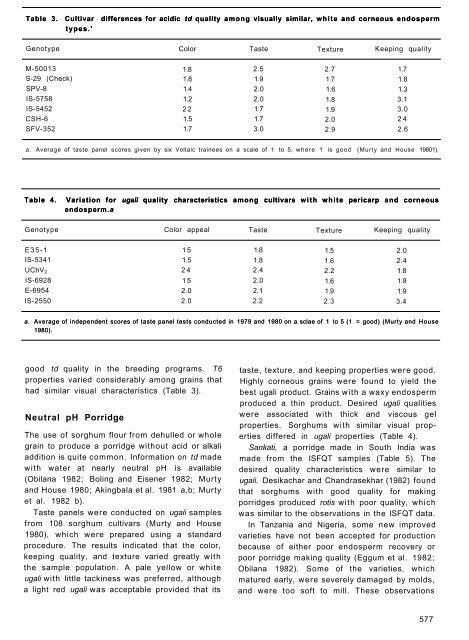RA 00048.pdf - OAR@ICRISAT
RA 00048.pdf - OAR@ICRISAT
RA 00048.pdf - OAR@ICRISAT
You also want an ePaper? Increase the reach of your titles
YUMPU automatically turns print PDFs into web optimized ePapers that Google loves.
Table 3. Cultivar differences for acidic td quality among visually similar, white and corneous endosperm<br />
types.'<br />
Genotype Color Taste Texture Keeping quality<br />
M-50013 1.8 2.5 2.7 1.7<br />
S-29 (Check) 1.8 1.9 1.7 1.8<br />
SPV-8 1.4 2.0 1.6 1.3<br />
IS-5758 1.2 2.0 1.8 3.1<br />
IS-5452 2 2 1.7 1.9 3.0<br />
CSH-6 1.5 1.7 2.0 2 4<br />
SFV-352 1.7 3.0 2.9 2.6<br />
a. Average of taste panel scores given by six Voltaic trainees on a scale of 1 to 5, where 1 is good (Murty and House 19801).<br />
Table 4.<br />
Variation for ugali quality characteristics among cultivars with white pericarp and corneous<br />
endosperm.a<br />
Genotype Color appeal Taste Texture Keeping quality<br />
E 3 5 - 1 1 5 1.8 1.5 2.0<br />
IS-5341 1.5 1.8 1.6 2.4<br />
UChV 2 2 4 2.4 2.2 1.8<br />
IS-6928 1 5 2.0 1.6 1.9<br />
E-6954 2.0 2.1 1.9 1.9<br />
IS-2550 2.0 2.2 2.3 3.4<br />
a. Average of independent scores of taste panel tests conducted in 1979 and 1980 on a sclae of 1 to 5 (1 = good) (Murty and House<br />
1980).<br />
good td quality in the breeding programs. T6<br />
properties varied considerably among grains that<br />
had similar visual characteristics (Table 3).<br />
Neutral pH Porridge<br />
The use of sorghum flour from dehulled or whole<br />
grain to produce a porridge without acid or alkali<br />
addition is quite common. Information on td made<br />
with water at nearly neutral pH is available<br />
(Obilana 1982; Boling and Eisener 1982; Murty<br />
and House 1980; Akingbala et al. 1981 a,b; Murty<br />
et al. 1982 b).<br />
Taste panels were conducted on ugali samples<br />
from 108 sorghum cultivars (Murty and House<br />
1980), which were prepared using a standard<br />
procedure. The results indicated that the color,<br />
keeping quality, and texture varied greatly with<br />
the sample population. A pale yellow or white<br />
ugali with little tackiness was preferred, although<br />
a light red ugali was acceptable provided that its<br />
taste, texture, and keeping properties were good.<br />
Highly corneous grains were found to yield the<br />
best ugali product. Grains with a waxy endosperm<br />
produced a thin product. Desired ugali qualities<br />
were associated with thick and viscous gel<br />
properties. Sorghums with similar visual properties<br />
differed in ugali properties (Table 4).<br />
Sankati, a porridge made in South India was<br />
made from the ISFQT samples (Table 5). The<br />
desired quality characteristics were similar to<br />
ugali. Desikachar and Chandrasekhar (1982) found<br />
that sorghums with good quality for making<br />
porridges produced rotis with poor quality, which<br />
was similar to the observations in the ISFQT data.<br />
In Tanzania and Nigeria, some new improved<br />
varieties have not been accepted for production<br />
because of either poor endosperm recovery or<br />
poor porridge making quality (Eggum et al. 1982;<br />
Obilana 1982). Some of the varieties, which<br />
matured early, were severely damaged by molds,<br />
and were too soft to mill. These observations<br />
577

















